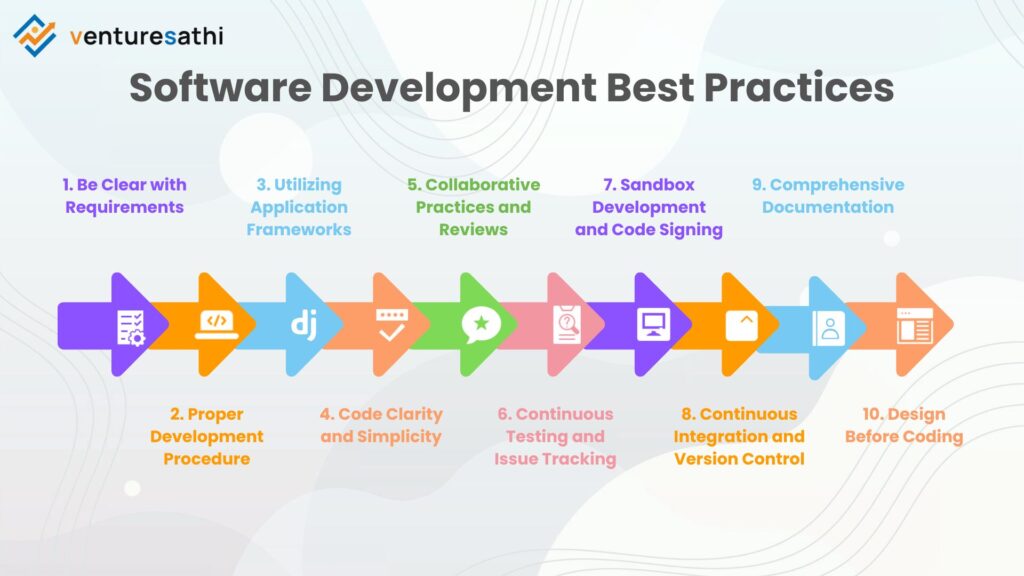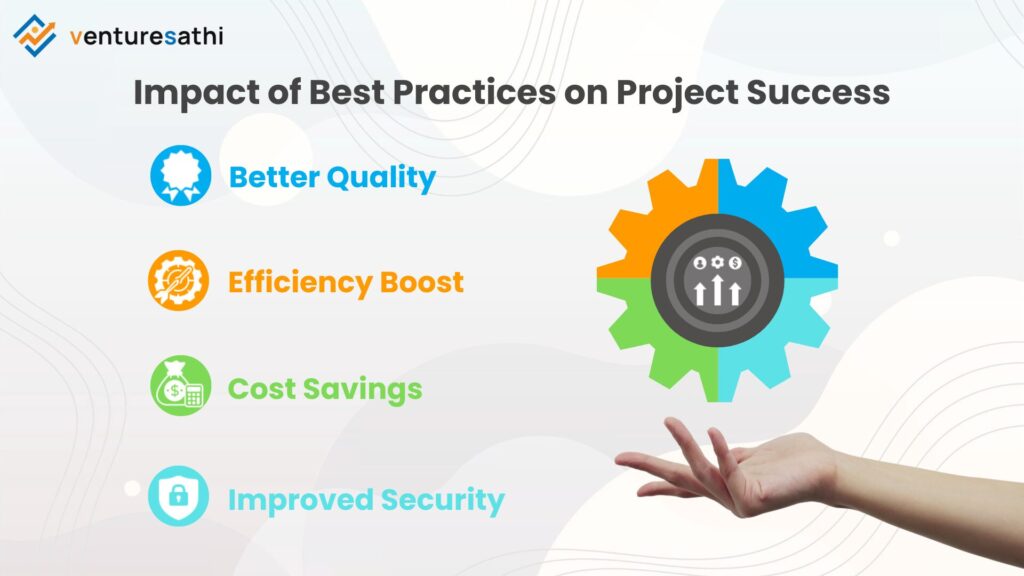Software development stands at the core of modern business operations, acting as the technological backbone that drives innovation, efficiency, and user engagement. However, the journey of software creation is intricate, demanding not only the right technology and tools but also adherence to precise techniques and methodologies. To navigate this complexity successfully, teams must adhere to best practices to ensure the delivery of a high-quality, maintainable, and efficient product.
The Importance of Best Practices in Software Development
The cost implications of software rework are substantial. According to a study by the DevOps Research and Assessment (DORA), software development teams end up revising approximately 26% of their code before its final release. These revisions, although crucial for refining the product, translate into significant time and resources. For a medium-sized corporation, these wasted hours can amount to an annual expense of at least $4.7 million, according to a report by The Standish Group International. This cost of rework escalates dramatically, almost paralleling the initial capital invested in the project. Thus, it becomes imperative to mitigate these expenses by diligently following established best practices right from the project’s initiation.
The ever-evolving software development landscape challenges teams to keep up with the latest methodologies and standards. Yet, adhering to proven best practices is essential to deliver high-quality software that meets client and end-user demands. In this blog, we explore top modern software development best practices. From building scalable architecture to maintaining stringent code quality, these fundamental techniques empower developers to optimize their processes and create software that meets the highest industry standards.
Software Development Best Practices

Below are modern software development practices aimed at assisting developers in crafting superior-quality software.
1. Be Clear with Requirements for Software Development Project
Clear and comprehensive requirements are essential for the success of any software project. They detail what the software should achieve, how it should function, and the user experience it should deliver. Gathering these requirements involves input from stakeholders like users, customers, and business analysts, ensuring they are complete, accurate, and aligned with everyone’s needs.
a. Documenting Requirements: The Role of SRS
An effective way to capture these requirements is through a Software Requirements Specification (SRS) document. This serves as a guide, ensuring that all requirements are met and processes are followed.
b. Functional and Non-functional Requirements
Understanding both functional and non-functional requirements is crucial. Functional requirements specify what the software should do, while non-functional requirements cover performance, security, and usability.
c. Implementing Best Practices
Creating a comprehensive Software Requirements Specification Document (SRSD) outlines all necessary requirements and design standards. This includes details like design characteristics, constraints, and diagrams, minimizing the need for constant clarification.
2. Proper Software Development Procedure
A systematic approach to software development is crucial for project success. The Software Development Life Cycle (SDLC) provides a structured framework, outlining clear objectives and steps to ensure alignment with goals. The choice of SDLC methodology depends on project requirements, client needs, specifications, and timelines.
a. SDLC Methodologies
SDLC methodologies come in various forms, each suited to different project dynamics:
Agile Development: This flexible approach focuses on teamwork and continuous improvement, breaking projects into manageable parts. Agile is ideal for projects requiring frequent updates, like web or mobile apps, and works well in dynamic environments with collaborative teams.
Waterfall Approach: A linear and methodical approach, Waterfall prioritizes a sequential development process. It’s suitable for projects with stable requirements, like business landing page websites, and is often preferred by novice developers for its structured nature.
b. Methodology Selection Factors
Several factors influence the choice of methodology:
Requirements Flexibility: Consider how likely requirements are to change. Agile handles evolving requirements well, while Waterfall suits projects with stable needs.
Project Scale: The project’s size impacts methodology selection. Some methodologies are better for large projects, while others are more efficient for smaller, focused tasks.
Time Constraints: Evaluate the project’s time constraints. Methodologies designed for quick deliverables suit projects with tight deadlines, while others allow for a more phased approach.
3. Utilizing Application Frameworks for Software Development Projects
Building software from scratch can be costly and time-consuming. Application frameworks offer a pre-built foundation with reusable components, libraries, and tools, speeding up development while adhering to industry standards. Frameworks like React.js for front-end development and Django for back-end applications streamline the process by removing repetitive tasks, allowing developers to focus on unique project functionalities.
a. Advantages of Framework Integration
Using application frameworks brings several benefits:
Error Reduction: Frameworks minimize errors, ensuring software reliability and cross-platform compatibility.
Time-Saving: Pre-built code and functionality save time on repetitive tasks like file conversions and database management.
Quality Assurance: Frameworks allow developers to concentrate on coding, enhancing software quality and reducing debugging efforts.
b. Choosing the Right Framework: A Checklist
Consider these factors when selecting a framework:
Programming Language Compatibility: Ensure the framework aligns with the project’s programming language for smooth integration.
Project-Specific Requirements: Choose a framework that fits the project’s features, size, and complexity.
Security and Reliability: Opt for frameworks with strong security features and scalability for future growth.
Feature Suitability: Make sure the framework meets all current and future project needs.
Performance Efficiency: Evaluate the framework’s ability to handle the workload efficiently and deliver optimal performance.
Comprehensive Documentation: Select frameworks with thorough documentation to ease the learning curve and speed up development.
Community Support: Prefer frameworks supported by active communities for reliable help and troubleshooting.
4. Code Clarity and Simplicity
Writing clear, well-documented, and maintainable code is crucial. It ensures readability, understandability, and ease of modification. Using meaningful variable names, concise functions, and embedded comments enhances comprehension and future improvements. Clear code fosters better collaboration and reduces the learning curve for new team members. Here are three key aspects to ensure code simplicity:
- Ease of Testing and Comprehension: Simple code is easily testable and understandable. It allows developers to comprehend its functionality swiftly and conduct efficient tests to ensure its reliability.
- Logic Boundaries within a Single Domain: Keeping logic confined within its respective domain promotes simplicity. By ensuring that functions or modules tackle a single task or domain, the code becomes clearer and more manageable.
- Conciseness over Excessive Comments: Code should speak for itself. When code requires fewer comments to explain its functionality, it exemplifies clarity and succinctness.
5. Collaborative Practices and Reviews
Embracing collaborative practices like pair programming, code reviews, and continuous feedback fosters a culture of learning and improvement within the development team. These practices enhance code quality through real-time collaboration and knowledge sharing.
a. Spot Errors and Enhance Codebase
Collaborative efforts, such as developers reviewing each other’s code, act as a discerning pair of eyes. They quickly identify and fix errors, strengthening the codebase and ensuring a robust software product.
b. Foster Idea Exchange and Knowledge Transfer
Collaborative practices enable the exchange of ideas and insights. This not only enriches the team’s collective knowledge but also serves as a valuable learning opportunity, especially for new team members.
c. The Significance of Code Reviews
Code reviews are vital for ensuring code quality and consistency.
Ensuring Compliance and Consistency: Code reviews ensure that all code aligns with set standards and practices, streamlining future development and reducing discrepancies.
Facilitating Best Practices: By reviewing each other’s code, team members reinforce and share best practices, elevating the overall quality of the codebase.
6. Continuous Testing and Issue Tracking
Continuous testing emerges as a cornerstone in this pursuit, enabling the early identification of errors and bugs that could potentially derail a project. Let’s delve into the significance of continuous testing and its symbiotic relationship with issue tracking in the software development process.
a. Continuous Testing
Continuous testing and issue tracking are crucial components of successful software development, ensuring early error detection and streamlined project management.
Early Error Detection: Conducting tests during development helps catch errors early, preventing them from escalating and saving time and effort.
Code Understanding and Improvement: Continuous testing provides a deeper understanding of the code, highlighting areas for refinement and improvement.
Seamless Integration with Development Workflow: Integrating testing into the workflow enhances agility, allowing for quick adjustments and fostering an iterative development approach.
b. Issue Tracking
Early Bug Identification: Issue tracking tools enable early reporting and resolution of bugs, preventing them from causing larger issues later on.
Project Transparency and Coordination: Issue trackers provide a centralized view of tasks and issues, promoting transparency and collaboration among team members.
7. Sandbox Development and Code Signing
Sandbox development and code signing are critical practices that enhance software security and integrity.
a. Sandbox Development: Fortifying Software Integrity
Virtual Machines: Utilizing virtual machines (VMs) as sandboxes provides a controlled environment for testing and managing software components. It facilitates:
Enhanced Security Layers: VMs offer a secure space to test upgrades, manage dependencies, and experiment with potentially unsafe third-party components.
Resource Segregation: Using complete operating systems within VMs or application containers like Docker adds an extra layer of defense against potential threats.
b. Code Signing Certificates
Code signing certificates establish the identity of software creators and validate software integrity. Here’s why they’re crucial:
Identity Verification: Code signing certificates verify the developer’s identity, ensuring software authenticity and trustworthiness.
Intellectual Property Protection: Code signing protects software from unauthorized tampering or distribution, safeguarding intellectual property.
c. Evolution of Software Signing
Digital signatures have revolutionized code signing, preventing unauthorized duplication and distribution, despite initial challenges with CD distribution.
8. Continuous Integration and Version Control
Continuous Integration (CI) and Version Control are essential for efficient code management and development lifecycle optimization.
a. Continuous Integration
Continuous Integration involves merging code changes from various contributors into a shared repository to validate code combinations.
b. The CI Process
To implement CI best practices, adhere to these steps:
Shared Code Repository: Utilize Git or a similar tool to establish a central repository for developers’ updates.
Automated Build Processes: Set up automated builds and testing to ensure comprehensive code evaluation.
Continuous Testing: Ensure testing occurs with each code alteration, fostering a culture of rigorous evaluation.
CI Server Management: Employ CI servers like Jenkins or Travis CI to oversee the build and testing processes.
Developer Accessibility: Enable team-wide access to CI servers, promoting visibility and collaboration.
Alert Mechanisms: Configure alerts for failed builds or tests, ensuring prompt issue resolution.
Team Commitment: Foster a shared understanding among team members regarding the significance and usage of CI.
Version Control: Harmonizing Collaborative Development
c. Importance of Version Control
Version control systems play a pivotal role in collaborative software development:
Simultaneous Work: They enable multiple developers to work concurrently on the same project without overwriting each other’s contributions.
Error Reversion: Facilitating rollback to earlier versions mitigates errors without impeding ongoing work.
d. Embracing Version Control Tools
Tools like Git and GitHub have revolutionized version control:
Git and GitHub: Widely embraced, they facilitate efficient version control and foster collaboration among developers.
GitHub’s Pull Requests: This feature enhances version control by merging explicit and redundant commits, ensuring a cleaner, more readable Git history.
9. Comprehensive Documentation
Detailed and up-to-date documentation acts as a crucial reference point for developers and stakeholders. It encompasses various aspects, including project requirements, system architecture, code documentation, user manuals, and troubleshooting guides.
a. The Purpose of Documentation
Documentation, in essence, is the recorded narrative of a software project, encompassing code changes, issue logs, resolutions, and more. Its primary objectives include:
Progress Tracking: A comprehensive log of work done, aiding in understanding past decisions and project evolution.
Error Mitigation: Learning from mistakes to avoid their recurrence and fortify future development efforts.
Collaboration Enabler: Assisting team members in understanding and building upon each other’s work.
b. Versatile Documentation Formats
Documentation takes diverse forms, each serving a distinct purpose:
Code Comments: Embedded within code to explain functionalities, rationales, and usage.
Commit Messages: Concise annotations accompanying code commits, highlighting changes and intentions.
Project Notes: Summarized records outlining milestones, challenges, and resolutions.
User Manuals: End-user guides detailing software functionality and operational instructions.
c. Best Practices in Code Documentation
To craft effective code documentation, adhere to these key principles:
Clarity and Simplicity: Employ plain language to elucidate code functionalities, operations, and reasoning behind implementation.
Diverse Documentation Styles: Employ comments, inline documentation, and external references for holistic code understanding.
Essential Documentation Items: Ensure the inclusion of crucial elements such as README files, API documentation, coding conventions, issue tracking, and licensing information.
10. Design Before Coding
To ensure exceptional software, it’s crucial to adhere to sound development practices. This involves planning and envisioning the application before writing any code. This meticulous planning includes detailing the software’s functionalities, user interface, and underlying architecture.
Designing before coding is essential as it ensures alignment with user and stakeholder requirements, identifies potential challenges early, and saves time and resources later on. Techniques like wireframing, prototyping, and mock-ups help developers visualize the software’s blueprint before coding.
This approach also ensures scalability and maintainability. A well-structured architecture allows for seamless integration of new features in the future, simplifies maintenance, and reduces debugging time.
Impact of Best Practices on Project Success

The benefits of adhering to best software development practices are multifaceted, offering a transformative impact on project outcomes:
Better Quality: By embracing these practices, software development ventures ensure the creation of robust, error-free, and user-centric applications, fostering reliability and usability.
Efficiency Boost: Efficiency becomes the hallmark of development endeavors, accelerating the pace of delivery, meeting deadlines, and optimizing resource allocation.
Cost Savings: The avoidance of common pitfalls and the rectification of inefficiencies render projects more cost-effective, resonating with fiscal prudence.
Improved Security: By integrating these practices, software fortifies itself against cyber threats, enhancing both application resilience and user protection.
Embrace Excellence in Software Development

Encouraging businesses to adopt these practices is crucial for staying competitive in today’s dynamic market. Embracing innovation through these methodologies isn’t just a choice, it’s a strategic necessity for sustained success. It’s a call to businesses to recognize the value these practices bring and to prioritize their adoption for better project outcomes.
As for engaging with a software development company, partnering with experts can significantly bolster the adoption and effective implementation of these best practices. Collaborating with seasoned professionals ensures a holistic approach to project development, leveraging their expertise to integrate these practices effectively. It’s an invitation to collaborate with professionals who understand these methodologies and can navigate their implementation seamlessly, ensuring project success.
Embracing software development best practices is not just an industry trend but a fundamental necessity for businesses aiming to stay competitive and innovative. At Venturesathi, we specialize in leveraging these practices to deliver bespoke software solutions tailored to your unique needs. We encourage businesses to adopt these practices, engage with us, and embark on a journey to elevate their business to new heights through innovation and excellence in software development.




Your article is really great! A lot of information about POS software development will be helpful to me, so keep sharing like this Mam/Sir. Good luck!
Fantastic information
Greetings from Idaho! I’m bored to death at work so I decided to browse your
site on my iphone during lunch break. I really like the information you provide here
and can’t wait to take a look when I get home.
I’m amazed at how quick your blog loaded on my cell phone ..
I’m not even using WIFI, just 3G .. Anyways, fantastic site!
This Content is good Informative. I appreciate your Experties about Software development